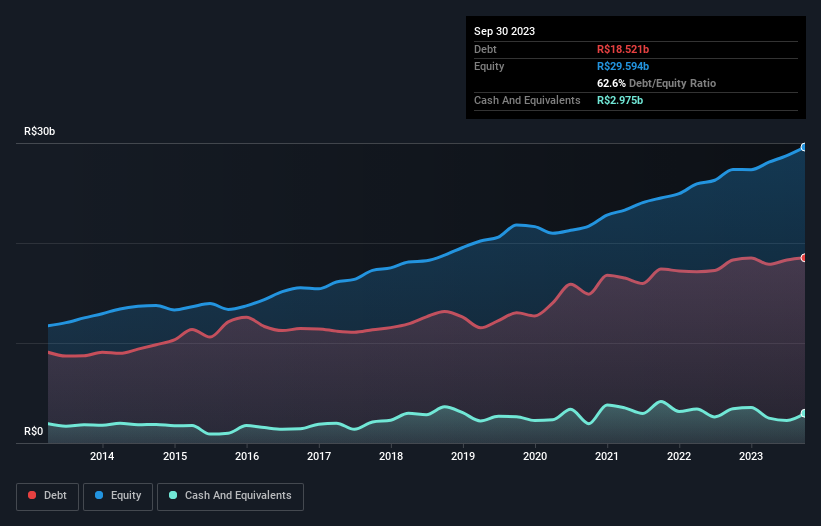- Brazil
- /
- Water Utilities
- /
- BOVESPA:SBSP3
These 4 Measures Indicate That Companhia de Saneamento Básico do Estado de São Paulo - SABESP (BVMF:SBSP3) Is Using Debt Reasonably Well

Warren Buffett famously said, 'Volatility is far from synonymous with risk.' So it might be obvious that you need to consider debt, when you think about how risky any given stock is, because too much debt can sink a company. We note that Companhia de Saneamento Básico do Estado de São Paulo - SABESP (BVMF:SBSP3) does have debt on its balance sheet. But the more important question is: how much risk is that debt creating?
When Is Debt Dangerous?
Debt and other liabilities become risky for a business when it cannot easily fulfill those obligations, either with free cash flow or by raising capital at an attractive price. Ultimately, if the company can't fulfill its legal obligations to repay debt, shareholders could walk away with nothing. However, a more usual (but still expensive) situation is where a company must dilute shareholders at a cheap share price simply to get debt under control. Having said that, the most common situation is where a company manages its debt reasonably well - and to its own advantage. When we think about a company's use of debt, we first look at cash and debt together.
View our latest analysis for Companhia de Saneamento Básico do Estado de São Paulo - SABESP
How Much Debt Does Companhia de Saneamento Básico do Estado de São Paulo - SABESP Carry?
The chart below, which you can click on for greater detail, shows that Companhia de Saneamento Básico do Estado de São Paulo - SABESP had R$18.5b in debt in September 2023; about the same as the year before. On the flip side, it has R$2.98b in cash leading to net debt of about R$15.5b.

A Look At Companhia de Saneamento Básico do Estado de São Paulo - SABESP's Liabilities
Zooming in on the latest balance sheet data, we can see that Companhia de Saneamento Básico do Estado de São Paulo - SABESP had liabilities of R$7.13b due within 12 months and liabilities of R$22.3b due beyond that. On the other hand, it had cash of R$2.98b and R$3.75b worth of receivables due within a year. So its liabilities outweigh the sum of its cash and (near-term) receivables by R$22.7b.
While this might seem like a lot, it is not so bad since Companhia de Saneamento Básico do Estado de São Paulo - SABESP has a huge market capitalization of R$53.8b, and so it could probably strengthen its balance sheet by raising capital if it needed to. However, it is still worthwhile taking a close look at its ability to pay off debt.
We use two main ratios to inform us about debt levels relative to earnings. The first is net debt divided by earnings before interest, tax, depreciation, and amortization (EBITDA), while the second is how many times its earnings before interest and tax (EBIT) covers its interest expense (or its interest cover, for short). This way, we consider both the absolute quantum of the debt, as well as the interest rates paid on it.
Companhia de Saneamento Básico do Estado de São Paulo - SABESP has net debt worth 2.0 times EBITDA, which isn't too much, but its interest cover looks a bit on the low side, with EBIT at only 6.2 times the interest expense. While these numbers do not alarm us, it's worth noting that the cost of the company's debt is having a real impact. One way Companhia de Saneamento Básico do Estado de São Paulo - SABESP could vanquish its debt would be if it stops borrowing more but continues to grow EBIT at around 20%, as it did over the last year. The balance sheet is clearly the area to focus on when you are analysing debt. But ultimately the future profitability of the business will decide if Companhia de Saneamento Básico do Estado de São Paulo - SABESP can strengthen its balance sheet over time. So if you're focused on the future you can check out this free report showing analyst profit forecasts.
But our final consideration is also important, because a company cannot pay debt with paper profits; it needs cold hard cash. So the logical step is to look at the proportion of that EBIT that is matched by actual free cash flow. In the last three years, Companhia de Saneamento Básico do Estado de São Paulo - SABESP created free cash flow amounting to 9.3% of its EBIT, an uninspiring performance. For us, cash conversion that low sparks a little paranoia about is ability to extinguish debt.
Our View
On our analysis Companhia de Saneamento Básico do Estado de São Paulo - SABESP's EBIT growth rate should signal that it won't have too much trouble with its debt. However, our other observations weren't so heartening. For instance it seems like it has to struggle a bit to convert EBIT to free cash flow. We would also note that Water Utilities industry companies like Companhia de Saneamento Básico do Estado de São Paulo - SABESP commonly do use debt without problems. When we consider all the factors mentioned above, we do feel a bit cautious about Companhia de Saneamento Básico do Estado de São Paulo - SABESP's use of debt. While debt does have its upside in higher potential returns, we think shareholders should definitely consider how debt levels might make the stock more risky. The balance sheet is clearly the area to focus on when you are analysing debt. However, not all investment risk resides within the balance sheet - far from it. For example - Companhia de Saneamento Básico do Estado de São Paulo - SABESP has 1 warning sign we think you should be aware of.
Of course, if you're the type of investor who prefers buying stocks without the burden of debt, then don't hesitate to discover our exclusive list of net cash growth stocks, today.
New: AI Stock Screener & Alerts
Our new AI Stock Screener scans the market every day to uncover opportunities.
• Dividend Powerhouses (3%+ Yield)
• Undervalued Small Caps with Insider Buying
• High growth Tech and AI Companies
Or build your own from over 50 metrics.
Have feedback on this article? Concerned about the content? Get in touch with us directly. Alternatively, email editorial-team (at) simplywallst.com.
This article by Simply Wall St is general in nature. We provide commentary based on historical data and analyst forecasts only using an unbiased methodology and our articles are not intended to be financial advice. It does not constitute a recommendation to buy or sell any stock, and does not take account of your objectives, or your financial situation. We aim to bring you long-term focused analysis driven by fundamental data. Note that our analysis may not factor in the latest price-sensitive company announcements or qualitative material. Simply Wall St has no position in any stocks mentioned.
About BOVESPA:SBSP3
Companhia de Saneamento Básico do Estado de São Paulo - SABESP
Provides basic and environmental sanitation services in the São Paulo State, Brazil.
Outstanding track record and undervalued.

